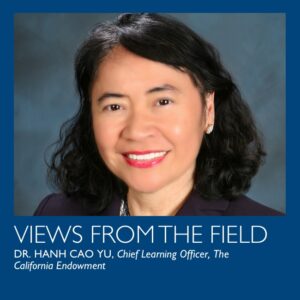Dr. Hanh Cao Yu, Chief Learning Officer, The California Endowment
Despite a commitment to transformation, equity, and rebalancing the scales of justice, philanthropy often operates in ways that undermine its very purpose. Historically, the philanthropic field has taken a siloed and narrow approach to change, offering investments in short-term funding cycles and attempting to create change from the top down.
Investing in grassroots power building remains an effective solution to counter philanthropy’s historical missteps.
Put simply, power building can be defined as investments in people—particularly people most impacted by injustice. These communities know better than any of us what they need, and through collective action, can make transformative change a reality.
Investing in those people and trusting their wisdom, ideas, and perspectives is the best way to move through systemic injustice and begin to see the light at the end of the tunnel.
Lasting change begins and ends with people. And, oftentimes, the ability to truly impact change from the ground up simply comes down to resource availability, powerful networked connections, accessibility—and trust.
That’s where all of us come in.
Lessons Learned from Building Healthy Communities
In 2010, The California Endowment set out to advance health equity and improve health outcomes in 14 communities throughout California through Building Healthy Communities. We focused on historically disinvested communities of color throughout California, including:
- Boyle Heights
- Central Santa Ana
- Central / Southeast / Southwest Fresno
- City Heights
- Del Norte and Tribal Lands
- Eastern Coachella Valley
- East Oakland
- East Salinas (Alisal)
- Long Beach
- Richmond
- South Sacramento
- South Los Angeles
- South Kern
- Southwest Merced / East Merced County
We invested nearly $1.8 billion and made more than 10,000 grants to grassroots community organizations, coalitions, state policy advocates, and more.
Through strategic mobilization, this network of advocates, organizations, and communities were able to become a catalyst for actual, real-world change. The movement led to more than 1,700 local policy changes, public systems improvements, and other benefits to communities.
The Center for Outcomes Research and Evaluation, Center for the Study of Social Policy, and other evaluation partners measured the impact of Building Healthy Communities investments and found a wealth of other changes, including:
- increased civic engagement,
- youth-led change leading to more school interconnectedness,
- improvements to housing and land use in target communities,
- four million Californians getting healthcare coverage,
- school suspensions being cut in half over the decade of the work, and
- a sharp drop in youth incarceration rates
In many cases, these transformational changes spilled over into surrounding communities. And we want to take it even further.
The last 10 years have informed the next decade of our work to build a more just and equitable California. By expanding our scope to include regions with the most acute health and racial inequities, we are partnering with people on the ground who are leading transformational changes.
In this decade of our work, we are moving toward the goal of creating a robust and intergenerational power-building ecosystem in California by 2030. We’ll do this through expanding community-led changes, supporting grassroots organizing, building capacity of organizations already on the ground, and growing a broader movement fighting for health equity and social justice.
We envision a California with health, justice, and racial equity for all. Together, we know that we can make it happen.
A Framework For Investing in Powerbuilding – That We Can All Follow
Investing in building power can take different forms. It’s important to keep in mind that this isn’t a formula to programmatically copy. You can replicate this model, but keep in mind the theory of impact behind it.
For Building Healthy Communities, we structured investments across five dimensions:
- A multigenerational timeline: Adopting a long-term view to prioritize investments that will lead to lasting change.
- An ecosystem mindset: Focusing on building coalitions and networks that can create the power to change inequitable systems through collaboration and influence.
- Bedrock priorities: Providing core operating support for grassroots organizing, youth mobilization, a youth leadership pipeline, and voter engagement.
- Collaborative funding: Pooling investments together in an effort to make change more scalable.
- Adaptive learning: Supporting the ability to learn and adapt to shifting contexts and political environments in an effort to make power building stronger and more sustainable over time.
To create an ecosystem of networked organizations, we also focused on building capacity for grassroots organizations to grow and scale, challenge racist or unjust policies, and shift narratives in a way that makes pursuing equity goals more achievable.
The power building model is not unique to The California Endowment. The methods, strategies, and framework we used can be replicated by other foundations searching for a way to support lasting change.
There are challenges to a power building model, of course, and at the same time, understanding the importance of power building is critical and increasingly relevant as economic inequality grows, racial injustice persists, and public policies fail to keep pace with the growing crisis across California.
Perhaps most importantly, we in philanthropy must become comfortable challenging the status quo. When we do, we can actually get out of our own way and stand by the intention of philanthropy in the first place—transformation, equity, and justice. For the people, by the people.
If you’d like to learn more about Building Healthy Communities, our investment framework, or why power building is an effective catalyst to change, you can read our article “Philanthropic Investment in People Power” in the Stanford Social Innovation Review.

